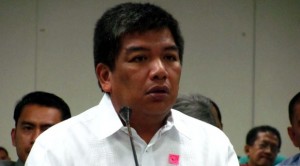SULTAN KUDARAT, Maguindanao —Armed with shovels and other earth-moving equipment, local residents and officials of the Autonomous Region in Muslim Mindanao have been piling up dirt on the northern bank of the Rio Grande de Mindanao to build a nearly four-kilometer-long dike meant to stop floodwaters from invading the town’s farms and homes.
The perennial overflowing of the Rio Grande leaves substantial damage to farms and homes in the area apart from disrupting land transportation between the neighboring city of Cotabato and Davao City and slowing down trade and commerce.
Led by ARMM Governor Mujiv Hataman and other officials, local residents started piling up soil on a 3.75-kilometer stretch of riverbank between Barangay Katuli dowstream to Barangay Bagobo.
Makmod Mending Jr., ARMM’s secretary of agriculture and fisheries, said the dike would also serve as a farm-to-market road between the two villages.
“The project started Wednesday with a first-tranche of P3 million from the ARMM government. This would help [prevent] huge damage to crops and properties and even lives from risks posed by floods,” Mending said.
He said the initiative was the result of a region-wide consultation among member-organizations of the Regional Agriculture Fishery Council (RAFC), during which ARMM farmers and fishermen presented their problems and concerns.
Hataman noted that road traffic between the cities of Davao and Cotabato gets regularly disrupted by the flooding of a section of the highway in this part of Sultan Kudarat town, slowing down regional trade and commerce.
This affects Maguindanao and the rest of the ARMM as well. Despite not being part of the ARMM, Cotabato City remains a major center of commerce and trade for the region, Hataman said.
The problem of flooding here appears to worsen each year, especially when the rains come. From June this year, the floods have become a monthly problem.
In October, a 10-year-old child died when floods submerged the low-lying villages of this town and at least 9,800 villagers were affected, according to the Humanitarian Emergency Assistance and Relief Team (HEART) of the ARMM.
“It’s been a constant problem (flooding) here,” Sultan Kudarat Mayor Shamim Mastura said back then.
The problem has been aggravated by the overgrowth of water hyacinth and siltation.
The Mindanao River Basin Project, led by the Mindanao Development Authority (Minda), formed a technical working group to find ways to address the recurring problem on flooding here and in other parts of Mindanao.
During its meetings, the technical working group said there was a need for structural interventions such as flood-control projects and non-structural interventions that include reforestation, mangrove rehabilitation, and sustainable watershed management.
“Both of these structural and non-structural interventions are aimed to address the issue of flooding beyond a piece-meal method and are part of the strategic programs prioritized in the MRB Master Plan which adopts the ridge-to-reef approach,” Luwalhati Antonino, the Minda chair, said in July.
(With reports from Dennis Santos and Edwin Fernandez, Inquirer Mindanao)
RELATED STORIES
Infra, reforestation projects on track to solving flooding in Mindanao, says Minda
Bridge linking Cotabato City, towns to Davao City may collapse
